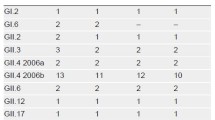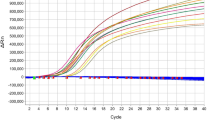Abstract
Rapid detection of emerging virulent human noroviruses (Genogroups I and II) from clinical and food samples remains an on-going challenge. Development of internal amplification controls (IACs) in real-time RT-PCR assays to eliminate false negatives due to sample inhibition or reaction failure is critical. RNA IACs were constructed for application with two sets of previously described highly reactive degenerate primers (MON and COG) for the detection of human noroviruses (HNoVs) GI and GII. These primer sets were compared for detection sensitivity of HNoVs from outbreak stool samples (6 GI and 9 GII) by SYBR Green I based real-time reverse-transcriptase (RT)-PCR. In order to detect viruses directly from stool samples, heat release was used to expose the viral RNA (95°C, 10 min). PCR conditions were optimized for each primer set before and also after IAC addition to obtain similar detection limits. Both primer sets showed equal detection limits for GII strains (4 log RT-PCR U/sample) and with one-log higher detection for GI strains (10−5 end-point dilution; 5 log RT-PCR U/sample). The melt temperature (T m) of the COG and MON IAC were 83°C (155 bp) and 83.5°C (150 bp), respectively. Product T m were 84°C (using MON primers for both genogroups) and 81.5°C (COG for GI) and 84°C (COG for GII). Agarose gel electrophoresis determined product sizes as 85 and 98 bp for GI and GII with COG, respectively, and 213 bp with MON for both genogroups. From our study, COG primers appear to have a broader detection range than the MON primers, using the 15 tested stool samples. This assay can potentially be implemented for routine HNoV detection from clinical and food samples.





Similar content being viewed by others
References
Abdulmawjood, A., Roth, S., & Bulte, M. (2002). Two methods for construction of internal amplification controls for the detection of Escherichia coli O157 by polymerase chain reaction. Molecular and Cellular Probes, 16, 335–339.
Ando, T., Monroe, S. S., Gentsch, J. R., et al. (1995). Detection and differentiation of antigenically distinct small round-structured viruses (Norwalk-like viruses) by reverse transcription-PCR and southern hybridization. Journal of Clinical Microbiology, 33, 64–71.
Atmar, R. L., Neill, F. H., & Le Guyader, F. S. (2008) Detection of human caliciviruses in fecal samples by RT-PCR. Diagnostic Virology Protocols, Methods in Molecular Biology, 665. doi: 10.1007/978-1-60761-817-1_3.
Brightwell, G., Pearce, M., & Leslie, D. (1998). Development of internal controls for PCR detection of Bacillus anthracis. Molecular and Cellular Probes, 12, 367–377.
Bustin, S. A., Benes, V., Nolan, T., & Pfaffl, M. W. (2005). Quantitative real-time RT-PCR—a perspective. Journal of Molecular Endocrinology, 34, 597–601.
D’Souza, H. D., Critzer, F. J., & Golden, D. A. (2009). Real-time reverse-transcriptase polymerase chain reaction for the rapid detection of Salmonella using invA primers. Foodborne Pathogens and Disease, 6, 1097–1106.
Escobar-Herrera, J., Cancio, C., Guzman, G. I., et al. (2006). Construction of an internal RT-PCR standard control for the detection of human caliciviruses in stool. Journal of Virological Methods, 137, 334–338.
Hoorfar, J., Malorny, B., Abdulmawjood, A., et al. (2004). Practical considerations in design of internal amplification controls for diagnostic PCR assays. Journal of Clinical Microbiology, 42, 1863–1868.
Kageyama, T., Kojima, S., Shinohara, M., et al. (2003). Broadly reactive and highly sensitive assay for Norwalk-like viruses based on real-time quantitative reverse transcription-PCR. Journal of Clinical Microbiology, 41, 1548–1557.
Koopmans, M., & Duizer, E. (2004). Foodborne viruses: an emerging problem. International Journal of Food Microbiology, 90, 23–41.
Koopmans, M., Vennema, H., Heersma, H., et al. (2003). Early identification of common-source foodborne virus outbreaks in Europe. Emerging Infectious Diseases, 9, 1136–1142.
Kricka, L. J. (2002). Stains, labels and detection strategies for nucleic acid assays. Annals of Clinical Biochemistry, 39, 114–129.
Kroneman, A., Harris, J., Vennema, H., et al. (2008). Data quality of 5 years of central norovirus outbreak reporting in the European Network for food-borne viruses. Journal of Public Health, 30(1), 82–90.
Lantz, P. G., Matsson, M., Wadstrom, T., & Radstrom, P. (1997). Removal of PCR inhibitors from human fecal samples through the use of an aqueous two-phase system for sample preparation prior to PCR. Journal of Microbiological Methods, 28, 159–167.
Mattison, K., & Bidawid, S. (2009). Analytical methods for food and environmental viruses. Food and Environmental Virology, 1, 107–122.
Mead, P. S., Slutsker, L., Dietz, V., et al. (1999). Food-related illness and death in the United States. Emerging Infectious Diseases, 5, 607–625.
Richards, G. P., Watson, M. A., Fankhauser, R. L., & Monroe, S. S. (2004a). Genogroup I and II noroviruses detected in stool samples by real-time reverse transcription-PCR using highly degenerate universal primers. Applied and Environmental Microbiology, 70, 7179–7184.
Richards, G. P., Watson, M. A., & Kingsley, D. H. (2004b). A SYBR green, real-time RT-PCR method to detect and quantitate Norwalk virus in stools. Journal of Virological Methods, 116, 63–70.
Ririe, K. M., Rasmussen, R. P., & Wittwer, C. T. (1997). Product differentiation by analysis of DNA melting curves during the polymerase chain reaction. Analytical Biochemistry, 245, 154–160.
Rodriguez-Lazaro, D., D’Agostino, M., Pla, M., & Cook, N. (2004). Construction strategy for an internal amplification control for real-time diagnostic assays using nucleic acid sequence-based amplification: development and clinical application. Journal of Clinical Microbiology, 42, 5832–5836.
Sachadyn, P., & Kur, J. (1998). The construction and use of a PCR internal control. Molecular and Cellular Probes, 12, 259–262.
Schwab, K. J., Estes, M. K., Neill, F. H., & Atmar, R. T. (1997). Use of heat release and an internal RNA standard control in reverse transcription-PCR detection of Norwalk virus from stool samples. Journal of Clinical Microbiology, 35, 511–514.
Trujillo, A. A., McCaustland, K. A., Zheng, D. P., et al. (2006). Use of TaqMan real-time reverse transcription-PCR for rapid detection, quantification, and typing of noroviruses. Journal of Clinical Microbiology, 44, 1405–1412.
Vinje, J., Vennema, H., Maunula, L., et al. (2003). International collaborative study to compare reverse transcriptase PCR assays for detection and genotyping of noroviruses. Journal of Clinical Microbiology, 41, 1423–1433.
Widdowson, M. A., & Vinje, J. (2008). Food-borne viruses—state of art. In M. P. G. Koopmans, D. O. Cliver, & A. Bosch (Eds.), Food-borne viruses progress and challenges (pp. 29–64). Washington, DC: ASM Press.
Zheng, D., Ando, T., Fankhauser, R. L., et al. (2006). Norovirus classification and proposed strain nomenclature. Virology, 346, 312–323.
Acknowledgments
Funding for the research that was provided by the TN Agricultural Experiment Station (UT-TEN-HATCH #00391) and the FULBRIGHT PROGRAM (Grant #68432926) are gratefully acknowledged. Dr. Dragoslava Radin was a Fulbright Scholar under the mentorship of Dr. Doris H. D’Souza at FST, UT-Knoxville.
Author information
Authors and Affiliations
Corresponding author
Rights and permissions
About this article
Cite this article
Radin, D., D’Souza, D.H. Evaluation of Two Primer Sets Using Newly Developed Internal Amplification Controls for Rapid Human Norovirus Detection by SYBR Green I Based Real-Time RT-PCR. Food Environ Virol 3, 61–69 (2011). https://doi.org/10.1007/s12560-011-9057-6
Received:
Accepted:
Published:
Issue Date:
DOI: https://doi.org/10.1007/s12560-011-9057-6




